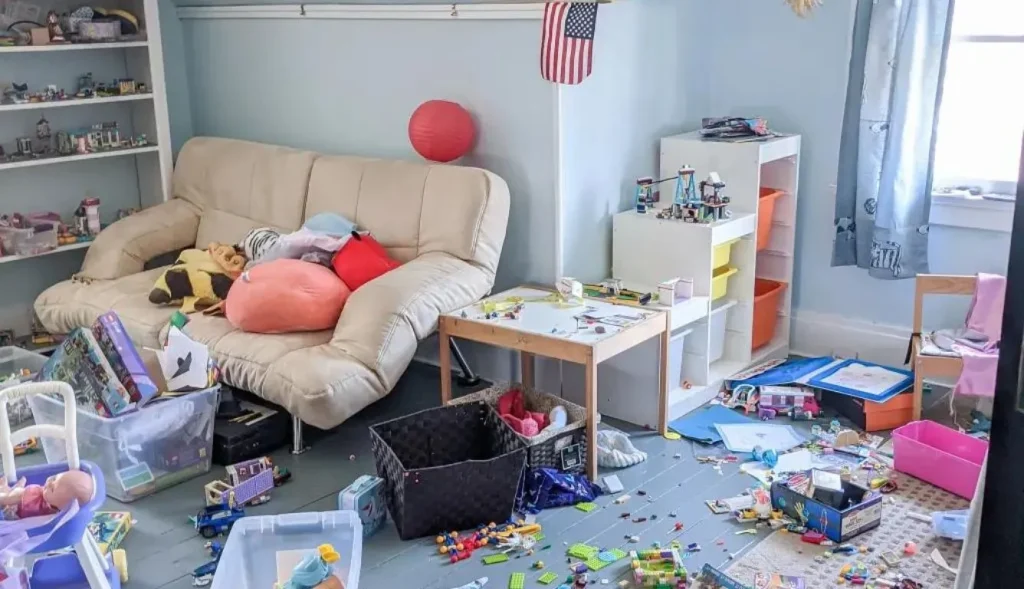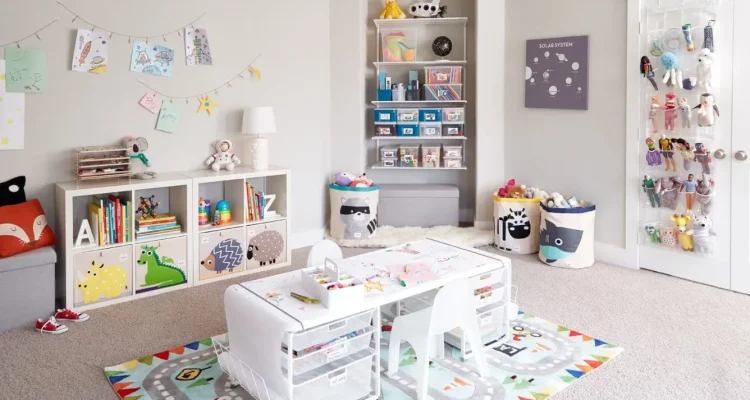Introduction
Organizing a playroom can feel like a daunting task, but it doesn’t have to be. An organized playroom not only looks great but also creates a safe and stimulating environment for your children to play and learn. In this article, we’ll walk you through step-by-step on how to transform your chaotic playroom into a well-ordered haven of fun and creativity.

Understanding Your Space
Assessing the Room Size
Before diving into organization, it’s crucial to understand the space you have. Measure the dimensions of the room and take note of any architectural features like windows, doors, and built-in storage. This will help you plan an efficient layout.
Determining the Layout
Think about how you want the playroom to function. Will it be a multi-purpose space for playing, learning, and crafting? Sketch a basic floor plan, marking where larger items like shelves and play tables will go.
Decluttering: The First Step
Sorting Toys
Start by sorting through all the toys. Create three piles: keep, donate, and discard. This process can be therapeutic and sets the foundation for an organized space.
Donating and Disposing
Donate gently used toys to local charities or shelters. Broken or unsafe toys should be discarded. Teaching your children to let go of toys they no longer use is a valuable lesson in generosity and mindfulness.
Storage Solutions
Utilizing Shelves and Cabinets
Invest in sturdy shelves and cabinets. Open shelves are great for displaying frequently used toys, while cabinets can store less-used items out of sight. Make sure they are secured to the wall to prevent tipping.
Bins and Baskets
Bins and baskets are lifesavers when it comes to organizing smaller toys. Clear plastic bins make it easy to see what’s inside, while decorative baskets add a touch of style.
Labeling Everything
Labeling bins and shelves can make a huge difference. Use pictures for younger children and words for older kids. This helps them know where everything belongs and encourages them to put things back after use.
Designating Play Areas
Creating Zones
Divide the playroom into specific zones for different activities. This not only helps with organization but also makes the space more functional and fun.
Reading Nooks
A cozy reading nook can foster a love for books. Use a small bookshelf, some comfy cushions, and a soft rug to create an inviting space.
Art and Craft Station
Set up an art and craft station with a small table, child-safe scissors, glue, and other craft supplies. Encourage creativity by making everything easily accessible.
Toy Storage Area
Designate a specific area for toy storage. Use a combination of shelves, bins, and baskets to keep toys organized and within reach.
Safety First
Child-Proofing the Playroom
Ensure that the playroom is a safe environment. Cover electrical outlets, secure heavy furniture to the walls, and remove any small objects that could be choking hazards.
Choosing Safe Furniture
Opt for furniture with rounded edges and avoid pieces that are too tall or unstable. Safety should always be a priority when designing a playroom.
Choosing the Right Furniture
Multi-functional Furniture
Multi-functional furniture, like a table with storage or a sofa bed, can save space and add versatility to the playroom.
Child-Sized Furniture
Furniture that fits your child’s size is not only cute but also functional. It makes the playroom more accessible and comfortable for them.
Creative and Educational Spaces
Incorporating Learning Tools
Incorporate educational tools like puzzles, building blocks, and interactive games. These can stimulate your child’s mind and support their development.
Encouraging Imagination
Provide toys and materials that encourage imaginative play, such as dress-up clothes, play kitchens, and building sets.
Involving Your Child
Getting Your Child’s Input
Let your child be part of the organization process. Ask for their input on what they want in their playroom and how they think it should be organized.
Teaching Organizational Skills
Use this as an opportunity to teach your child about organization. Show them how to sort, store, and take care of their belongings.
Maintenance Tips
Regular Clean-Up Routines
Establish a daily or weekly clean-up routine. Make it a fun activity by turning it into a game or playing music while you tidy up.
Seasonal Toy Rotation
Rotate toys every few months to keep the playroom fresh and exciting. Store away some toys and bring them out later to make them feel new again.
Incorporating Themes and Decor
Themed Playrooms
Consider incorporating a theme into your playroom, whether it’s a favorite character, hobby, or color scheme. Themes can make the space more exciting and personalized.
Personalizing the Space
Add personal touches like your child’s artwork, photos, or a growth chart. These details make the playroom feel special and uniquely theirs.
Budget-Friendly Ideas
DIY Solutions
Get creative with DIY solutions. Repurpose old furniture, make your own wall art, or craft storage solutions from household items.
Shopping Smart
Look for sales, discounts, and second-hand items. You can find great deals on quality items that fit your budget.
Technology in the Playroom
Balancing Screen Time
While technology can be a valuable educational tool, it’s important to balance screen time with other activities. Set limits and encourage a variety of play.
Using Educational Apps
Incorporate educational apps that promote learning and creativity. Choose age-appropriate apps that are both fun and educational.
Adapting as They Grow
Evolving the Space with Your Child
As your child grows, their interests and needs will change. Be prepared to adapt the playroom to accommodate their evolving preferences.
Future-Proofing the Playroom
Choose flexible furniture and storage solutions that can grow with your child. This will save you time and money in the long run.
FAQs
How do I start organizing a cluttered playroom?
Begin by sorting through all the toys and items in the playroom. Create piles for keeping, donating, and discarding. This will give you a clear idea of what you have and what you need to store.
What are some must-have storage solutions for a playroom?
Shelves, cabinets, bins, and baskets are essential for keeping a playroom organized. Labeling these storage solutions can also help in maintaining order.
How can I keep the playroom safe for my children?
Ensure that all furniture is child-safe, secure heavy items to the walls, cover electrical outlets, and remove small objects that could be choking hazards.
How do I involve my child in organizing their playroom?
Get your child’s input on how they want their playroom to look and function. Teach them organizational skills by showing them how to sort and store their toys.
What are some budget-friendly ways to organize a playroom?
Consider DIY solutions and look for sales, discounts, and second-hand items. Repurposing old furniture and making your own storage solutions can also be cost-effective.
Conclusion
Organizing a playroom might seem overwhelming at first, but with a clear plan and a bit of creativity, you can create a space that’s both functional and fun. Remember, the goal is to create a safe, engaging environment where your child can play, learn, and grow. So, roll up your sleeves and get started on transforming your playroom today!


Congratulation!